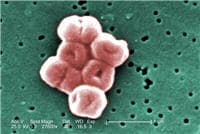 Many posts on this blog are about beneficial microbes, and the many species of microbes (bacteria, fungi, viruses) living within and on us. But there are also bacteria in the world that pose a serious threat to human health, and the list of these are growing due to antibiotic resistance. This week the World Health Organization (WHO) officials came out with a list of a dozen antibiotic-resistant "priority pathogens" that pose the greatest threats to human health. These are bacteria resistant to multiple antibiotics - thus superbugs.
Many posts on this blog are about beneficial microbes, and the many species of microbes (bacteria, fungi, viruses) living within and on us. But there are also bacteria in the world that pose a serious threat to human health, and the list of these are growing due to antibiotic resistance. This week the World Health Organization (WHO) officials came out with a list of a dozen antibiotic-resistant "priority pathogens" that pose the greatest threats to human health. These are bacteria resistant to multiple antibiotics - thus superbugs.
Antibiotic resistance is increasing due to misuse of antibiotics (or antimicrobials), and this is occurring throughout the world (post with video of how superbugs evolve). This is because bacteria are constantly evolving against the antibiotics they're exposed to. We may reach a point where simple cuts or infections could lead to death because no antibiotics will work. The World Health Organization said in a 2014 report that: "The problem is so serious that it threatens the achievements of modern medicine. A post-antibiotic era—in which common infections and minor injuries can kill—far from being an apocalyptic fantasy, is instead a very real possibility for the twenty-first century."
Part of the problem is that farmers are still giving antibiotics (antimicrobials) to farm animals unnecessarily, typically as "growth promoters" or to try to prevent disease. Currently about 80% of all antibiotics used in the US are given to livestock animals (of which nearly 70 percent of those used are considered “medically important” for humans).
New antibiotic development is not keeping pace with the emergence of new antibiotic resistant bacteria. According to the CDC: "Each year in the United States, at least 2 million people become infected with bacteria that are resistant to antibiotics and at least 23,000 people die each year as a direct result of these infections."
According to WHO officials "The bacteria on the list are responsible for severe infections and high mortality rates mostly in hospitalized patients, transplant recipients, those receiving chemotherapy or patients in intensive care units." They have also been seen in our hospitalized and returning military service people. The WHO list is meant to steer public and private research dollars toward developing new antibiotics for these particular families of bacteria. Pharmaceutical companies currently lack financial incentives to develop new drugs aimed at these superbugs. Currently too few new antibiotics are under development. From World Health Organization:
WHO publishes list of bacteria for which new antibiotics are urgently needed
WHO today published its first ever list of antibiotic-resistant "priority pathogens" – a catalogue of 12 families of bacteria that pose the greatest threat to human health. The list was drawn up in a bid to guide and promote research and development (R&D) of new antibiotics, as part of WHO’s efforts to address growing global resistance to antimicrobial medicines. The list highlights in particular the threat of gram-negative bacteria that are resistant to multiple antibiotics. These bacteria have built-in abilities to find new ways to resist treatment and can pass along genetic material that allows other bacteria to become drug-resistant as well.....The WHO list is divided into three categories according to the urgency of need for new antibiotics: critical, high and medium priority.
The most critical group of all includes multidrug resistant bacteria that pose a particular threat in hospitals, nursing homes, and among patients whose care requires devices such as ventilators and blood catheters. They include Acinetobacter, Pseudomonas and various Enterobacteriaceae (including Klebsiella, E. coli, Serratia, and Proteus). They can cause severe and often deadly infections such as bloodstream infections and pneumonia. These bacteria have become resistant to a large number of antibiotics, including carbapenems and third generation cephalosporins – the best available antibiotics for treating multi-drug resistant bacteria. The second and third tiers in the list – the high and medium priority categories – contain other increasingly drug-resistant bacteria that cause more common diseases such as gonorrhoea and food poisoning caused by salmonella.
WHO priority pathogens list for R&D of new antibiotics: Priority 1: CRITICAL - Acinetobacter baumannii, carbapenem-resistant, Pseudomonas aeruginosa, carbapenem resistant, Enterobacteriaceae, carbapenem-resistant, ESBL-producing. Priority 2: HIGH - Enterococcus faecium, vancomycin-resistant, Staphylococcus aureus, methicillin-resistant, vancomycin-intermediate and resistant, Helicobacter pylori, clarithromycin-resistant, Campylobacter spp., fluoroquinolone-resistant, Salmonellae, fluoroquinolone-resistant, Neisseria gonorrhoeae, cephalosporin-resistant, fluoroquinolone-resistant. Priority 3: MEDIUM - Streptococcus pneumoniae, penicillin-non-susceptible, Haemophilus influenzae, ampicillin-resistant, Shigella spp., fluoroquinolone-resistant.
 Acinetobacter baumannii Credit: Centers for Disease Control and Prevention (CDC)
Acinetobacter baumannii Credit: Centers for Disease Control and Prevention (CDC)
